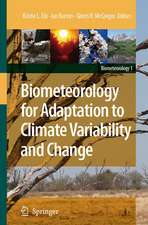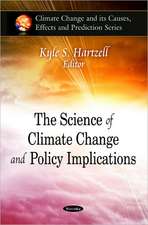Climate: Global Change and Local Adaptation: NATO Science for Peace and Security Series C: Environmental Security
Editat de Igor Linkov, Todd S. Bridgesen Limba Engleză Paperback – 26 aug 2011
| Toate formatele și edițiile | Preț | Express |
|---|---|---|
| Paperback (1) | 1230.66 lei 6-8 săpt. | |
| SPRINGER NETHERLANDS – 26 aug 2011 | 1230.66 lei 6-8 săpt. | |
| Hardback (1) | 1235.43 lei 6-8 săpt. | |
| SPRINGER NETHERLANDS – 26 aug 2011 | 1235.43 lei 6-8 săpt. |
Din seria NATO Science for Peace and Security Series C: Environmental Security
- 18%
 Preț: 1106.00 lei
Preț: 1106.00 lei - 15%
 Preț: 659.70 lei
Preț: 659.70 lei - 18%
 Preț: 999.60 lei
Preț: 999.60 lei - 18%
 Preț: 1221.07 lei
Preț: 1221.07 lei - 18%
 Preț: 1220.75 lei
Preț: 1220.75 lei - 18%
 Preț: 940.39 lei
Preț: 940.39 lei - 18%
 Preț: 1216.78 lei
Preț: 1216.78 lei - 18%
 Preț: 1232.71 lei
Preț: 1232.71 lei - 18%
 Preț: 1818.02 lei
Preț: 1818.02 lei - 18%
 Preț: 1833.95 lei
Preț: 1833.95 lei - 18%
 Preț: 1231.47 lei
Preț: 1231.47 lei - 18%
 Preț: 942.44 lei
Preț: 942.44 lei - 18%
 Preț: 1218.06 lei
Preț: 1218.06 lei - 18%
 Preț: 1383.00 lei
Preț: 1383.00 lei - 15%
 Preț: 664.29 lei
Preț: 664.29 lei - 18%
 Preț: 1220.88 lei
Preț: 1220.88 lei - 24%
 Preț: 1040.03 lei
Preț: 1040.03 lei - 18%
 Preț: 1222.80 lei
Preț: 1222.80 lei - 18%
 Preț: 1220.75 lei
Preț: 1220.75 lei - 18%
 Preț: 1224.85 lei
Preț: 1224.85 lei - 18%
 Preț: 1224.85 lei
Preț: 1224.85 lei - 18%
 Preț: 1224.68 lei
Preț: 1224.68 lei - 18%
 Preț: 963.15 lei
Preț: 963.15 lei - 18%
 Preț: 1229.10 lei
Preț: 1229.10 lei - 18%
 Preț: 1222.49 lei
Preț: 1222.49 lei - 18%
 Preț: 1223.74 lei
Preț: 1223.74 lei - 18%
 Preț: 1213.65 lei
Preț: 1213.65 lei - 18%
 Preț: 956.33 lei
Preț: 956.33 lei - 18%
 Preț: 1235.43 lei
Preț: 1235.43 lei - 18%
 Preț: 940.39 lei
Preț: 940.39 lei - 18%
 Preț: 1210.63 lei
Preț: 1210.63 lei - 18%
 Preț: 1219.63 lei
Preț: 1219.63 lei - 18%
 Preț: 1225.48 lei
Preț: 1225.48 lei - 18%
 Preț: 1228.75 lei
Preț: 1228.75 lei - 18%
 Preț: 1228.62 lei
Preț: 1228.62 lei - 18%
 Preț: 1222.94 lei
Preț: 1222.94 lei - 18%
 Preț: 962.98 lei
Preț: 962.98 lei - 18%
 Preț: 1218.06 lei
Preț: 1218.06 lei - 15%
 Preț: 643.99 lei
Preț: 643.99 lei - 18%
 Preț: 1220.12 lei
Preț: 1220.12 lei - 18%
 Preț: 1233.52 lei
Preț: 1233.52 lei - 18%
 Preț: 946.24 lei
Preț: 946.24 lei - 18%
 Preț: 1218.21 lei
Preț: 1218.21 lei - 18%
 Preț: 953.65 lei
Preț: 953.65 lei
Preț: 1230.66 lei
Preț vechi: 1500.81 lei
-18% Nou
Puncte Express: 1846
Preț estimativ în valută:
235.52€ • 244.97$ • 194.43£
235.52€ • 244.97$ • 194.43£
Carte tipărită la comandă
Livrare economică 14-28 aprilie
Preluare comenzi: 021 569.72.76
Specificații
ISBN-13: 9789400717725
ISBN-10: 9400717725
Pagini: 806
Ilustrații: XIV, 598 p. 141 illus.
Dimensiuni: 155 x 235 x 35 mm
Greutate: 0.82 kg
Ediția:2011
Editura: SPRINGER NETHERLANDS
Colecția Springer
Seria NATO Science for Peace and Security Series C: Environmental Security
Locul publicării:Dordrecht, Netherlands
ISBN-10: 9400717725
Pagini: 806
Ilustrații: XIV, 598 p. 141 illus.
Dimensiuni: 155 x 235 x 35 mm
Greutate: 0.82 kg
Ediția:2011
Editura: SPRINGER NETHERLANDS
Colecția Springer
Seria NATO Science for Peace and Security Series C: Environmental Security
Locul publicării:Dordrecht, Netherlands
Public țintă
GraduateCuprins
1. Climate Change Challenges. Climate Change and New Security Challenges.- Climate Adaptation.- U.S. Army Corps of Engineers’ Collaborative Approach to 21st Century Challenges Posed by Global Change.- 2. Climate Change Adaptation as a Risk-Based Decision Problem. Model Relevance.- Multiple Dimensions of Vulnerability and Its Influence on Adaptation Planning and Decision Making.- Adaptation as a Decision Making Under Deep Uncertainty.- What Social Science and Risk Analysis Can Teach Us about Local Adaptation.- Risk Management Practices.- Adaptation to Climate Change.- Uncertainties in the Cost-Benefit Analysis of Adaptation Measures, and Consequences for Decision Making.- Sustainable Development and Climate Change Challenges.- Adapting Cities to Climate Change.- Adapting to Climate Change—A Wicked Problem.- 3. National Security Applications and Needs. National Security Perspectives on Addressing Instabilities Arising from Climate Change Impacts on the Environment.- Climate Change, Scarcities, and the Resulting Challenges for Civil Protection.- A Critical Review of the Linkage between International Security and Climate Change.- The U.S. Navy’s Approach to Climate Change and Sea Level Rise.- Energy Security: Using Multicriteria Decision Analysis to Select Power Supply Alternatives for Small Settlements.- Climate Change Impacts and Adaptation on CONUS Military Installations.- 4. Coastal Applications. Adaptation in Coastal Systems.- U.S. Army Corps of Engineers Approach to Water Resources Climate Change Adaptation.- Mapping Sea Level from Space.- Integrated Modeling to Mitigate Climate Change Risk Due to Sea level Rise.- Recent Climate Change, Projected Impacts, and Adaptation Capacity in Iceland.- 5. Inland Applications. Adaptation of Inland Systems to Climate Change with Challenges and Opportunities for Physical, Social, and Engineering Disciplines.- Influence of Climate Change on Reservoir Water Quality Assessment and Management.- Climate Risks.-Climate Change: Costs of Impacts in France.- Climate Change.- Adaptation Challenges for Water and Waste Management in the U.S. and China.- Adaptation to Climate Change and Other Emergent Conditions with Inland and Terrestrial Infrastructure Systems with Application Case Studies.- Author Index.
Textul de pe ultima copertă
Rising sea levels and altered weather patterns are expected to significantly alter coastal and inland environments for humans, infrastructure and ecosystems. Potential land-use changes and population increases, coupled with uncertain predictions for sea level rise and storm frequency/intensity represent a significant planning challenge. While efforts to mitigate climate change continue, plans must be made to adapt to the risks that climate change poses to humans, infrastructure, and ecosystems alike. This book addresses integrated environmental assessment and management as part of the nexus of climate change adaptation. Risk analysis has emerged as a useful approach to guide assessment, communication and management of security risks. However, with respect to climate change, an integrated, multi-criteria, multi-hazard, risk-informed decision framework is desirable for evaluating adaptation strategies. The papers in Part 1 summarize societal and political needs for climate change adaptation. Part 2 includes papers summarizing the state of the art in climate change adaptation. Three further parts cover: the process of change in coastal regions, in inland regions, and, finally, the potential challenges to homeland security for national governments. Each of these parts reviews achievements, identifies gaps in current knowledge, and suggests research priorities.
Caracteristici
State-of-the science approach to climate change adaptation Focus on practical applications and management solutions Use of advanced quantitative tools to address policy problems


























